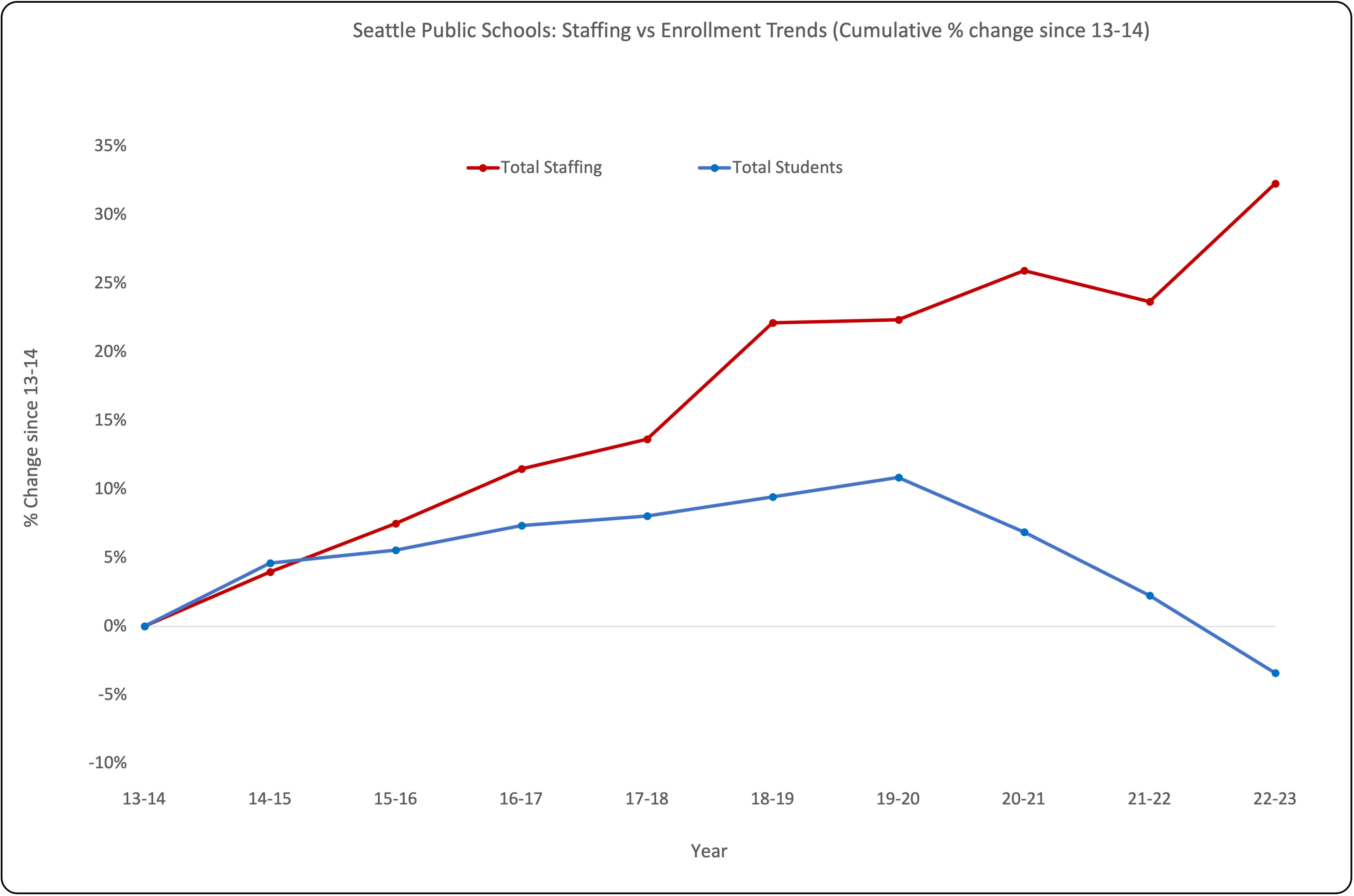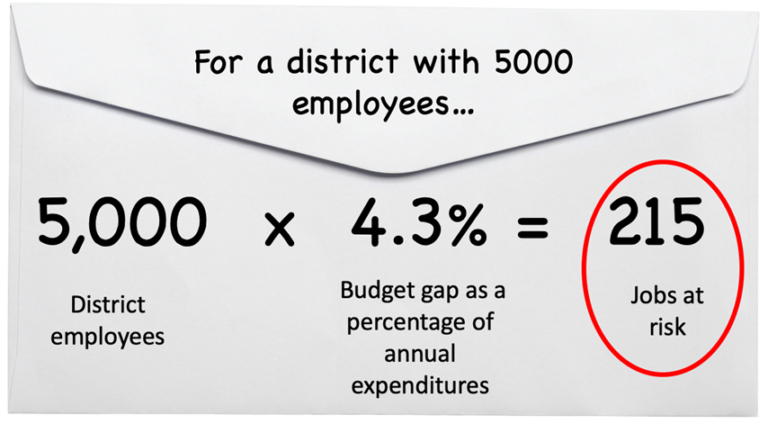Marguerite Roza
March 2023
The next two years will be messy ones for district finances. The biggest-ever one-time injection of federal cash (known as ESSER) has 18 months left. As that money runs out, a perfect storm of financial pressures will eclipse any most districts have seen before. Our analysis suggests the gaps in 2024-25 will be worse than the last recession.
District financial teams should see it coming—it’s right there in the budget forecasts—even though few are at the point of sharing out scenarios publicly. In fact, most district leaders don’t yet have a plan for how to navigate the financial headwinds. Those plans will start to take shape in the next few months—and come with big consequences for downstream financial solvency, teacher and staff layoffs, school closures, and ultimately for students.
Much of this planning goes down in a sleeper set of district meetings: budget workshops held between January and May. It’s here, with very little fanfare, that a mix of board members and district leaders hammer out key decisions that can impact districts, schools, staff, and students for years to come.
For this spring’s budget discussions, I suggest focusing on these six critical issues:
#1. Are ESSER investments getting students back on track?
Before grappling with the forecast, every district should be tracking whether its ESSER investments are working to address pandemic-era learning gaps. Are math and reading scores coming back up? Is attendance improving? With only 18 months remaining on these funds, district leaders need to pivot now if their investments aren’t delivering real value for students.
Calling attention to student outcomes alongside finance deliberations isn’t typical, but it should be. (In some places, like St. Paul, it’s happening.)
#2. What’s the magnitude of any forecasted budget gaps?
When the ESSER tap abruptly goes dry, most districts will see a year-to-year reduction in spending. That’s the “fiscal cliff.” We estimate the average district will have to cut costs by some $1,200 per student in 2024-25.
One can assume that the easy spending cuts (e.g., eliminating contracted services) are already baked into the figures. When the forecast shows a deficit, it means that more active cutting is required to balance the budget. That’s what happens when districts make recurring commitments that outpace the revenue stream, for instance when districts used ESSER funds to pay for new hires or grant permanent raises.
Recent decisions will play a role here. Some have played it safe, awarding only modest or one-time pay bumps and stashing funds away in reserves. Others made larger than typical inflation-era raises, with some making a risky assumption that their legislatures will fully cover the gap.
#3. Are enrollment and staffing trends headed in the same direction?

Over time, enrollment drives revenues while staffing drives expenses. Nationally, enrollment is falling while staffing counts are climbing. Fewer students usually means fewer staff, but many districts have used their relief funds to both hold on to existing employees and even add more in the form of new counselors, reading specialists, nurses, etc. For Seattle, those concerning patterns are on display here. (To graph your own district’s staffing and enrollment trends, use this template).
One obvious decision is whether (and how) to reduce staffing counts when relief funding ends—or if not, how to pay for them. While Detroit notified some staff that their positions will be eliminated, in most districts plans to right-size the district are still in the very early stages.
#4. What options is the district considering to balance its budget?
It’s not unusual for leaders to put off making tough (and unpopular) budget-cutting decisions. But any delay can just make a bad situation worse, especially if the overspending continues in the interim. Ultimately, when it comes time to cut budgets, most start with a commitment to protect students and classrooms, and minimize job losses.
Beyond those statements, the next steps typically involve some months of tinkering around the edges (postponing maintenance, freezing hiring, or cutting contracts). In the end, if the budget gap represents more than about 2% of the total district budget, districts have no choice but to cut labor costs (labor being some 80-90% of the budget).
A better process would be to get clear on the magnitude of the deficit and move quickly to surface several budget cutting options (complete with numbers) for public debate. An easy way to start is to ballpark the number of jobs at risk using the back-of-the-envelope calculation pictured here. As shown, the basic calculation is number of employees times the budget gap as a percentage of annual spending.

When it comes to cutting labor, eliminating jobs isn’t the only path (although it does help convey the magnitude of the challenges ahead). Reducing labor costs can also take the form of eliminating school days (via furloughs), scaling back benefits, or suspending pay raises. Getting some concrete options on the table can help communities process the range of different options and provide input.
When making layoffs, leaders will need to decide who gets let go. A common default is to use seniority (aka last-in, first-out or LIFO). LIFO tends to disproportionately hit high-needs schools, where less experienced teachers tend to be concentrated. It also often results in eliminating teachers of color.
#5. Are school closures warranted?
School closures are emotional affairs. But what the drama often misses is what’s at stake for families. Given the magnitude of the gaps, a district can only afford so many staff. In a district with enrollment declines, the question becomes whether the district will spread those staff across a larger number of under-enrolled buildings, or concentrate those staff in a smaller number of more fully enrolled sites. With the former, there are fewer staff in each building, and that means students at all schools forego some of their specialists (music teachers, counselors, and the like) in order to ensure all buildings have a set of core staff (principal, core teachers, PE teacher, etc.). Is it better for kids to stay in a school with a skeleton crew or shift schools for one that’s got a full complement of staff? That’s a debate worth having.
Where closures are warranted, there are different strategies districts can consider in the process. Of particular interest is whether the district weighs each school’s performance in deciding if it gets closed. (Students reassigned to another school tend to fare better when they’re moved to a higher-performing one.)
#6. Will the state intervene if a district keeps overspending?
Some states have policies that get triggered when a district appears headed for insolvency. Those policies typically include monitoring and support, then escalate to oversight and eventually (although rarely) state takeover. When a district is struggling with shaky finances, it’s worth making sure everyone understands how and when that oversight gets triggered and who the key players are.
Adapted from a commentary originally published on Kappan’s The Grade, March 8, 2023.


